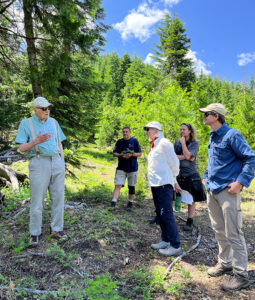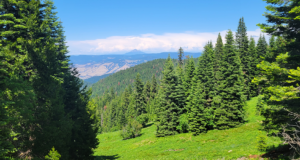
Summer 2023
Managing for Climate Resilience on Mount Ashland Demonstration Forest

PFT Board member Jerry Franklin (left) is a key member of our Mount Ashland Forest Management Advisory Committee.
This summer, leading forest ecologists, silviculturalists, wildlife biologists and indigenous cultural practitioners are joining with PFT staff to help develop the first 10-year management plan for our new 1,130-acre Mount Ashland Demonstration Forest. In bringing together the best available climate science and traditional ecological knowledge to inform our management, we are learning so much!
Located at the junction of the Klamath River and Rogue River basins, where the Cascades meet the Siskiyous, Mount Ashland Demonstration Forest has all the beauty and biodiversity of this world-famous region—a tremendous variety of plants and wildlife, abundant cold-water springs, complex soils and topography. Yet it also exemplifies the challenges forests face across the west, trying to adapt to hotter, drier conditions driven by climate change. A hundred years of industrial timber management, combined with fire exclusion and suppression, as well as the loss of indigenous fire management, has shaped this forest so that it has more young trees in more dense stands than before. This, in combination with climate change driven extreme drought and dramatically hotter summers, has led to increased death of trees and greater threats of severe wildfire than existed before.

Wet meadows are a key habitat on the Mount Ashland Demonstration Forest.
While much of this dilemma has been created by peoples’ choices, we are fortunate to be able to get expert guidance to begin making new choices that embody new hope for climate resilience for forests, wildlife, people, and communities. The forests shaped by the native peoples of the Siskiyous shows us that forests can be managed for lower intensity, more frequent “good fire.” Those healthier forests were less dense with trees, and had many more big, old trees with fire resistant bark than we see today. PFT is looking to this history as well as taking into consideration future changes that are already visible, such as the widespread loss of white fir and the shift to more ponderosa pine. We look forward to sharing the results of our planning and then the management of our Mount Ashland Demonstration Forest so that other forest owners, large and small, as well as communities and policy-makers can join us in learning new ideas for managing climate resilient forests in changing times.
More in this Issue of ForestLife
- President’s Letter: Aren’t we there yet?
- Saving the Source: Conserving 11,000 acres of the Trinity River Headwaters
- Harnessing the Power of Nature to Address Climate Change
- Donor Profile: Barbara and Mark Daugherty
- Beyond the Trees: Our New Award-Winning Film
- Celebrating 30 Years and Forest Wildlife: Forest Fete 2023
